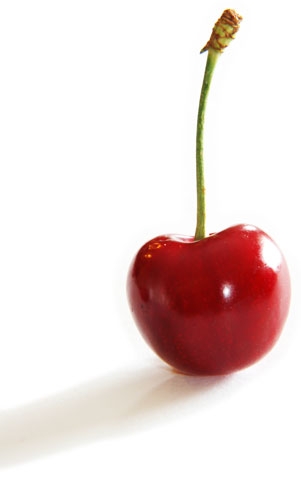A cherry is not an apple: With most temperate woody fruit species, such as the apple, the major increase in fruit size comes long after the canopy has been developed.
However, in the cherry, early fruit development and even maturation come at the same time as leaf and shoot development.
Photosynthates (continued from last issue)
With most temperate woody fruit species, such as the apple, the major increase in fruit size comes long after the canopy has been developed.
However, in the cherry, early fruit development and even maturation come at the same time as leaf and shoot development.
The problem of simultaneous fruit and canopy development is a partitioning question. As the cherry devotes a substantial portion of its photosynthates to the production of new leaves and shoots, it must also divert (partition) a portion of these products to grow big, firm cherries.
Photosynthates used initially in new shoot and leaf growth are not available for fruit growth. But, when fully developed, these same leaves are essential sources of photosynthates for fruit growth.
Postharvest management
The real challenge in postharvest management of cherries is to delay the loss of firmness and acidity and prevent pitting and stem browning.
Packing and storing cherries requires quite different thinking than handling apples because cherries have a much shorter window of maturity.
With apples it is a matter of days. With cherries it is a matter of hours.
Cherries are more sensitive to temperature, humidity and handling than apples.
Fruit skin
The delicate nature of the cherry skin can be realized when a comparison is made between a cherry and an apple skin.
The apple skin has several layers of cells with thick cell walls. The outermost layer of cells is impregnated with a thick layer of wax.
When the wax cuticle is removed from the apple and dried, its strength and flexibility become self-evident.
With great care the cherry cuticle can also be removed from the cherry skin. The cherry cuticle is very thin and easily torn as compared to the apple cuticle.
The greater bruising protection that is offered by the apple skin compared to the cherry skin is readily apparent when the combined strength of the cuticle and outer layers of each fruit is considered.
You can further appreciate the delicate nature of the cherry skin when you see the response of the skin in intact fruit to stresses of the weather.
Good quality cherries with a high glossy finish have a smooth wax finish beneath a circular border of wax build up to produce the appearance of a honeycomb structure on the cherry surface.
Stomates
Stomates also occur on the cherry surface of the skin but are non-functional in mature cherries.
Stomates are microscopically small openings through which water vapour and gasses pass and water is lost through transpiration; oxygen is taken up or absorbed in the process of respiration; and carbon dioxide is absorbed in the process of photosynthesis.
As a dark cherry matures to a mahogany colour, the moisture stress caused by transpiration through opened stomates results in the collapse of the skin cells that are adjacent to or near the stomates. This causes the stomates to appear recessed and gives the cherry a gravelly complexion.
A close look at blemishes that dull the cherry surface shows that the cells of the skin have become flaccid and concave.
Effects of water (cont next month)
See this article in Tree Fruit Oct 2019






















